"Israeli forces have been accused of executing handcuffed Palestinian medics before burying them in a mass grave underneath their crushed ambulances in southern Gaza's Rafah.
Fifteen humanitarian workers went missing last week after responding to a distress call from civilians being attacked by Israeli forces.
The workers include eight paramedics from the Palestine Red Crescent Society (PRCS), six members of the Palestinian Civil Defence search-and-rescue teams, and one UN staff member.
They were found over the weekend in a mass grave with at least around 20 multiple gunshots in each one of them, according to Mahmoud Basal, spokesperson for the Palestinian Civil Defence in Gaza.
At least one of them had their legs bound, another was decapitated and a third topless, he added.
The Palestinian health ministry said some of the bodies were found with their hands tied and with wounds in their heads and chests.
“Israeli occupation forces brutally savagely executed the Civil Defence teams,” Basal said.
He added the humanitarian workers were buried in a mass grave, two to three metres deep, in “an attempt to conceal the crime”.
“This grave was located just metres from their vehicles, indicating the [Israeli] occupation forces removed the victims from the vehicles, executed them, and then discarded their bodies in the pit,” he said.
“This scene represents one of the most brutal massacres Gaza has witnessed in modern history.”
Jonathan Whittall, head of UN's humanitarian affairs office in Palestine, said the mass grave was marked with the emergency light from one of the crushed ambulances.
The killings are the single deadliest attack on Red Cross/Red Crescent workers anywhere in the world since 2017, according to the International Committee of the Red Cross.
‘They were killed in their uniforms’
In a series of posts on X, Whittall explained what happened.
On 23 March, 10 PRCS and six Civil Defence first responders were dispatched to the area in Rafah where Israeli forces had advanced, to collect the wounded.
Israeli forces then struck the five ambulances and the fire truck, along with a UN vehicle that arrived later. Contact was lost with them.
The Israeli military said in an initial statement that trucks were struck because they were being used by Hamas and the Palestinian Islamic Jihad.
Both groups deny using ambulances for military purposes.
After five days of attempting to coordinate with the Israeli military to reach the area, UN teams were granted permission, Whittall said.
The UN teams “encountered hundreds of civilians fleeing under gunfire” and “witnessed a woman shot in the back of the head”, he added.
“When a young man tried to retrieve her, he too was shot. We were able to recover her body using our UN vehicle,” he said.
Six days after losing contact with the first responders, UN teams found the ambulances, the fire truck and the United Nations vehicle “crushed and partially buried”.
“After hours of digging, we recovered one body - a Civil Defence worker beneath his fire truck,” Whittall said.
The recovered body on Friday was that of Anwar Abdul Hamid Al-Attar, a humanitarian mission officer.
“On the first day of Eid, we returned and recovered the buried bodies of eight PRCS, six Civil Defence and one UN staff,” Whittall continued.
“They were killed in their uniforms. Driving their clearly marked vehicles. Wearing their gloves. On their way to save lives. This should never have happened.”
Israeli forces have killed at least 105 members of the Civil Defence, 27 PRCS paramedics, 284 UN agency staff and nearly 1,400 health ministry workers since the war on Gaza began in October 2023..."
[MEE]
"'One of them had his clothes removed and another one was beheaded' Palestinian Civil Defense spokesperson Mahmoud Basal gave a detailed account of the condition of the bodies of Palestinian Red Crescent and Civil Defense workers who were discovered buried in a mass grave in Tal al-Sultan, Rafah.
The victims had been executed at point-blank range by Israeli forces after being detained during a coordinated rescue mission. Their ambulances were later found bombed, and their bodies were missing for days until UN OCHA, Palestinian Civil Defense, and Red Crescent crews exhumed the mass grave.
The hands of many were zip-tied, and signs of field execution were evident on their corpses."
"A tragedy against humanitarian work.
The Red Crescent emblem, meant to protect you, has instead become the shroud that wrapped your bodies
Mustafa Khafaja, Ezzedine Shaat, Saleh Ma’amar, Rifaat Radwan, Mohammad Bahloul, Ashraf Abu Labda, Mohammad Al-Heila, and Raed Al-Sharif."
https://x.com/PalestineRCS/status/1906798112007757834
*Note: I volunteered with Palestinian medics of the Palestinian Red Crescent Society in January 2009, riding in their ambulances to document their work and who the victims they rescued were. The Israeli army killed one medic I had worked with, firing dart bomb directly at his ambulance, killing him. An Israeli sniper fired at least 14 shots at medics & another ambulance I was in, first targeting uniformed Palestinian medics, during ceasefire hours, shooting one medic in the leg and shooting our ambulance (video).
The ambulances did NOT carry Palestinian Resistance fighters, there were NO weapons in the ambulances. Israel claims this to justify the unjustifiable: slaughtering medics. [See my thread on X from October 2023 (after which Youtube deleted my entire channel)].
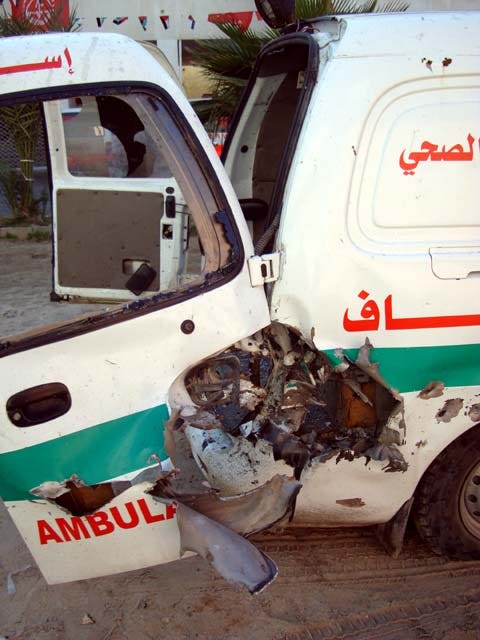

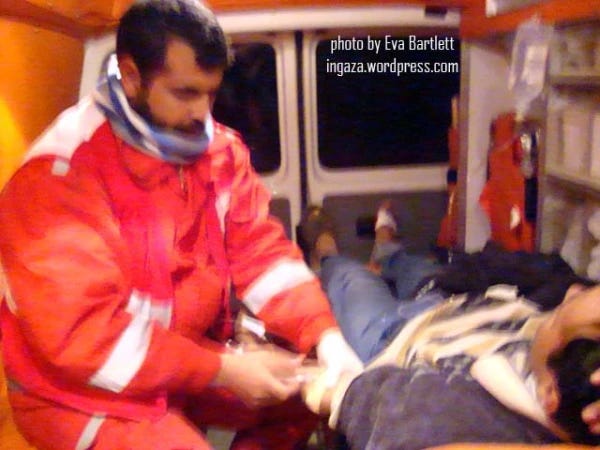

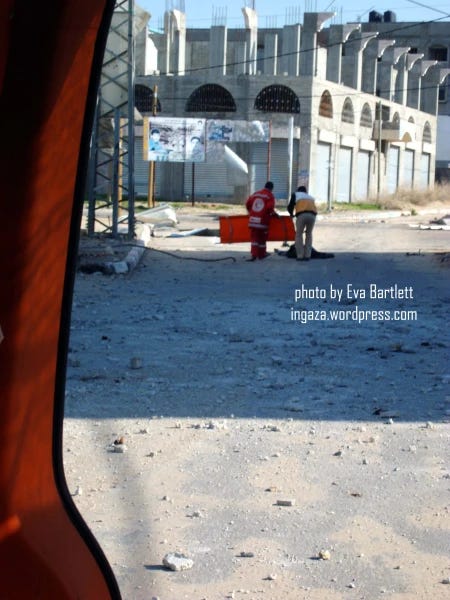
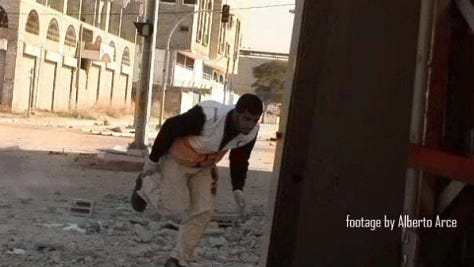
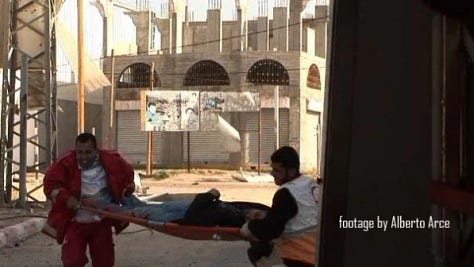
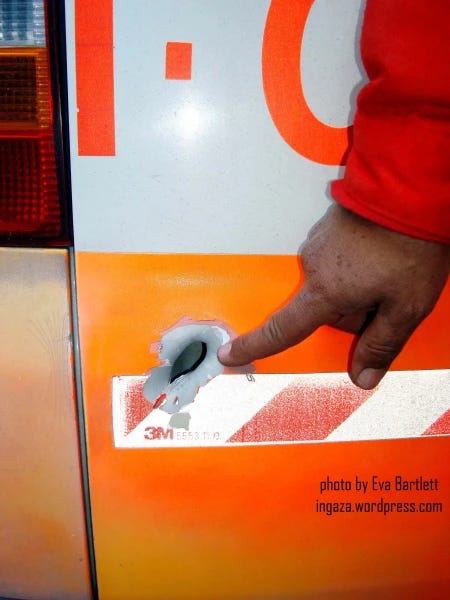

-Palestinian medics targeted by Israel, one year on:
Ali Khalil, 47, has served as a medic with the Palestine Red Crescent Society (PRCS) and private hospitals in Gaza for more than 20 years. He has seen some of the worst atrocities committed by the Israeli army. During Israel’s war on Gaza last winter, Khalil worked in Gaza’s northern region, venturing repeatedly into high-risk areas bombarded by Israeli tanks, helicopters and warplanes to rescue the injured and retrieve the dead.
During the 23-day invasion, the Israeli army warplanes, drones, warships, tanks and snipers rendered entire areas off-limits and impossible for ambulances and civil defense fire and rescue trucks to reach. In the north, Ezbet Abed Rabbo and Attatra, east and northwest of Jabaliya, respectively, were among the districts occupied by the Israeli army.
Through the International Committee of the Red Cross (ICRC), Palestinian rescuers were sometimes able to coordinate with the Israeli army to gain access to areas they controlled.
“We’d wait five hours, even over 30 hours, for coordination from the Israelis to enter the area to retrieve wounded or martyred,” says Khalil. “And much of the time, we wouldn’t get it.”
Even coordination, however, did not ensure access or safety.
“On 9 January, we went to retrieve wounded and martyred. There were three ambulances, and one ICRC jeep in front. We had coordination via the ICRC,” says Khalil.
Marwan Hammouda, 33, a PRCS medic for the last 10 years, was on the same call. “We were driving to the area, speaking with the Israelis on the phone. They’d tell us which way to drive, what road to take. When we got near the wounded, Israeli soldiers started firing. I told them, ‘We have coordination’ and they said to wait. Then they began firing at us again.”
According to the Palestinian Centre for Human Rights (PCHR), that same day, 9 January, Israeli soldiers fired on a convoy of 11 ambulances led by a clearly marked ICRC vehicle in central Gaza, injuring an ICRC staff member and damaging the vehicle.
This was not the only that occasion emergency medics came under fire. During the invasion, Israeli forces killed 23 medical rescuers, four in one day alone. Another 57 were injured. At least 16 ambulances were damaged with at least nine completely destroyed.
Although the Geneva Conventions explicitly state that “medical personnel searching, collecting, transporting or treating the wounded should be protected and respected in all circumstances,” throughout Israel’s invasion this was not the case. Indeed, as the injured and emergency workers testify, Israeli forces targeted and prevented medical workers from reaching the wounded.
“If we can’t even access areas with ICRC coordination, how are we supposed to help people?” asks Khalil.
Without coordination, many ambulances did not dare risk Israeli gunfire and shelling, meaning hundreds of calls went unanswered, according to PCHR. Denied medical care, many victims succumbed to their wounds.
It was days before ambulances could reach the bodies of at least five members of the Abu Halima family who were killed when Israeli shelling, including with white phosphorous, struck their home. In addition, two young male cousins, Matar and Muhammad, were shot dead by Israeli soldiers as they tried to drive a tractor-pulled wagon carrying the injured and martyred.
Ambulances trying to answer the calls were fired upon by machine guns and further shelling. Ali Khalil is still traumatized by what he and other emergency workers finally found days later.
“I brought back baby Shahed’s burned, gnawed corpse.”
The infant body that Khalil carried out, burned by white phosphorous, left in the tractor wagon, had been partially eaten by stray dogs.
“For the rest of my life I’ll remember that day. I’ll never get over it.”
Khalil is among many veteran medics who feel all the emergency workers need counseling for the stresses and traumas endured in their work.
Ahmed Abu Foul, 26, works as a medic and coordinator of all the PRCS volunteers in northern Gaza. He also works as a medic and coordinator with the Civil Defense, Gaza’s fire and rescue services. He is newly a father of a baby girl.
Abu Foul has narrowly escaped death while working on many occasions, and his body bears the scars of Israeli-fired bullet, shrapnel and flechette (dart bomb) injuries. In the last invasion alone, Abu Foul was twice targeted by snipers, was at the Fakhoura school when it was shelled on 6 January, and was in a building that was being bombed while emergency workers tried to evacuate the victims. In the latter incident, Abu Foul’s colleague was killed and Abu Foul was lacerated with shrapnel to the leg and head.
Despite his many close calls, Abu Foul maintains a convincingly cheerful attitude, and continues to work full time for both the Civil Defense and the PRCS. However, he admits the psychological and physical pain have not abated since the last Israeli attacks.
“My left leg is useless. When I walk too much, the pain becomes unbearable and my leg won’t support me. There’s still shrapnel in it, and the nerves were badly damaged by the shrapnel.”
It’s the same leg that was shot in May 2008 while Abu Foul was on a mission for PRCS, he says. Just above the support bandage around his calf, a hollow in his leg above his kneecap shows where the bullet bored straight through.
“A doctor here said he could remove the shrapnel and repair the nerves, but wanted to open it up from my foot all the way to my thigh,” he says of his recent injury.
“I have pain in my head also, especially when it is sunny. There’s still shrapnel in it from the shelling, although doctors already removed three pieces.”
He endures both injuries, waiting for specialists and the means outside of Gaza to remove the shrapnel. “It’s too dangerous here; we don’t have the means nor the medical equipment to locate the shrapnel before removing it.”
Aside from Abu Foul’s very present physical pain, it is memories of the wounded, the martyred, and the loss of his colleagues that still troubles him.
“I was with Dr. Issa Saleh coming down the stairs from the sixth floor of an apartment building in Jabaliya, evacuating a martyr, when the Israelis again shelled the building. They knew there were medics inside. They could see our uniforms and the ambulances outside. Dr. Saleh was hit by the missile.”
Abu Foul describes in testimony to the al-Mezan Center for Human Rights how he believed he’d been mortally wounded.
“I put my hand on the back of my head and I found blood and brain. I then saw Dr. Issa had been decapitated and realized it must have been his head hitting my head and his brain on the back of my head.”
Just days earlier, Abu Foul and other medics came under heavy Israeli fire for several minutes as they attempted to reach the injured.
The extreme stress and loss have manifested in Abu Foul’s daily life. “I feel as though I don’t care about anything now. Now, when I get angry I find myself hitting and throwing things. I feel nervous and I shout a lot now,” he told al-Mezan.
Yet Abu Foul takes his role as an emergency rescuer seriously and is not daunted in his work, in spite of how it has affected his personal life. Abu Foul now continues to seek replacement equipment, requesting delegations visiting Gaza to bring any sort of emergency equipment.
“Ten out of sixteen fire engines are functional. We need fire hoses, spotlights for the trucks, handheld spotlights for searching in the dark, chemical extinguishing spray, electric saws for cutting through wreckage …” The list is long and seems impossible when the Israeli siege on Gaza is tighter than ever.
Duty calls
“Each invasion becomes harder than the last,” says Marwan Hammouda. Like his colleagues, Hammouda has no fear of death, and like them he has a history of injuries in the line of work, the latest being a gunshot to his left foot when the ambulance he was driving came under Israeli fire in Jabaliya.
Since Israel’s invasion, Hammouda has developed a thyroid disorder, a condition doctors say is a result of post-traumatic stress.
“You saw the last war. There was nowhere safe, not homes, not schools, not kindergartens, not media buildings.” And not ambulances.
“So do I want to die in my home, or in my work, at least helping people who have been injured?” Hammouda asks. “The Israelis don’t have any respect for international law. And I have absolutely no confidence that things will change because American politicians give sweet speeches.”
Hammouda is cynical about the quality of life in Gaza and like many Palestinians is ready for the next Israeli attack at any time. “War is a business, Israel profits from it. Of course there will be another attack.”
‘The Israelis don’t have any respect for international law,” he says. “And I have absolutely no confidence that things will change because American politicians give sweet speeches,” he adds.
“My children got used to the idea that I could die at any moment in our work,” says the father of six. “During the Israeli attacks, I only saw them for five or ten minutes a day. Some days I didn’t see them at all because I was always with the ambulances.”
Hassan al-Attal, 35, a father of three, was shot by an Israeli sniper while carrying a body from Zimmo crossroads east of Jabaliya back towards the wailing, flashing ambulance.
Since the Israeli tanks rolled in with the land invasion after the first week of aerial bombardment, injured and trapped residents of Ezbet Abed Rabbo — one of the hardest-hit areas during the Israeli attacks — had been calling for ambulances to evacuate the wounded and the dead. In almost all cases, emergency rescuers were unable to reach these calls, hindered by Israeli army shooting and shelling.
A medic for ten years, Attal has on many occasions come under Israeli fire and aggression while working.
His gunshot injury during the 7 January mission at 1:30pm came during Israel’s self-declared “humanitarian cease-fire hours,” when civilians were told they could safely walk the streets to buy food supplies or otherwise leave their homes.
After carrying the corpse only a few meters, Israeli sniper fire broke out on Attal and Jamal Said, 21, the volunteer with him.
“We came under heavy fire, around 20 shots. I was shot in the left thigh,” says Attal.
Hazem Graith, 35, a father of four and a medic with the PRCS since 1999, worked in Gaza’s north during the Israeli attacks.
Like most medics, Graith came to the profession out of a sense of obligation to his community. “Because I love to help people,” he says.
Graith too has come under Israeli fire on many occasions. However, he is quick to emphasize that while the Israeli attacks on rescuers during last winter’s invasion were the most savage and numerous yet, they were not isolated incidents. Rather, they were part of a larger Israeli policy of denying access of emergency personnel to the wounded which dates back to the beginning of the second Palestinian intifada in September 2000.
According to statistics from the Palestinian Authority Ministry of Health and the PRCS, since the outbreak of the second intifada in September 2000, Israeli Occupation Forces (IOF) have killed at least 56 medical rescuers, including paramedics, drivers, doctors and volunteers –an average of one rescuer every two months – and have injured another at least 500 medical rescuers.
Since 2000 at least 144 Emergency Medical Team members have been arrested while on duty– including 64 between September 2000 and August 2002.
Of these, a total of 49 were beaten, 15 were tortured, six were used as human shields and six required hospitalisation.
Khaled Abu Sada, 43, another long-term medic, will never forget the Israeli attack that savagely martyred his colleague Arafa Abd al-Dayem.
On 4 January, at around 10am, medics Sada, Abd al-Dayem and PRCS volunteer Ala Sarhan, 23, answered the call of civilians targeted by Israeli tank shelling in northern Gaza’s Beit Lahiya.
As they brought the injured and martyred to the ambulance, the medic team was struck by an Israeli tank-fired dart bomb. The flechettes, just two inches long and dart-shaped, are designed to bore through anything, to break apart upon impact, to ensure maximum damage. Arafa Abd al-Dayem, 35, a father of four and volunteer medic for eight years, was shredded by the darts.
Abu Sada testified: “I came round here and found Arafa kneeling down with his hands in the air and praying to God. They found his body full of these nails. The guy that had been brought to the ambulance was in pieces. He was now missing his head and both his legs.”
Arafa Abd al-Dayem went into shock and died an hour or so after the attack, while Ala Sarhan was paralyzed by the injuries sustained in the attack.
Ashraf al-Khatib has been a medic for 11 years. During the Israeli attacks, he worked at Rafah’s PRCS station. “On 15 January we got a call from a man who said his brother was dead and he was injured by multiple Israeli gunshots. Ahmed and Ibrahim Thabet didn’t know the Israeli army were nearby when they rode their motorcycle through a district of eastern Rafah.”
Called at 11am, al-Khatib attempted to get Israeli coordination via the ICRC to reach the injured man.
“We tried for hours. Ibrahim kept calling us, crying, panicked. We explained we couldn’t reach the area because of the Israeli army. We told him how to stop his bleeding to his chest and leg until we arrived.”
Unable to wait any longer, al-Khatib and colleagues made the decision to risk going without Israeli coordination.
“I told them, we may die. But we agreed to go.”
Two ambulances reached the area and brought out the dead and injured men.
“We had snipers trained on us, lasers on our foreheads and chest,” he says.
Having reached the Thabet brothers, the medics saw more victims.
“It was a busy area. People didn’t know there were Israeli snipers nearby.”
But because of renewed Israeli firing, al-Khatib’s ambulances were forced to retreat, leaving the victims behind.
Al-Khatib recalls another well-known case in Gaza, that of the Shurrab family in Rafah.
“We got a call from Muhammad Shurrab saying he and his sons had been evicted from their home by Israeli soldiers, then shot. They were all living but injured,” he explained.
The family waited, trapped between an Israeli tank and their home, bleeding of their injuries, he says.
“We went, when we tried to reach them Israeli soldiers fired on us, so we retreated and tried to get coordination. Shurrab would call every so often; I’d tell him to be patient while we tried. It was winter, so in addition to their injuries, they were freezing.”
Al-Khatib relates the saga which went on through the night.
“Later, the father called to say one son had died. We called Al-Jazeera television and told them the Israelis were preventing us from reaching Shurrab. Al-Jazeera took his mobile number and interviewed him live on the air. By that time his second son had died. Twelve hours later the Israelis finally allowed us to reach him, but his sons were both dead.”
Al-Khatib says this was the worst challenge he has faced as a medic.
“I knew they were injured but there was no way to reach them, then the kids died. The Israeli army was playing with us,” he says.
Muhammad, who declined to give his last name, 30, a volunteer medic and ambulance driver at the Tel al-Hawa PRCS station, was among the team sent to retrieve injured from the Samouni neighborhood in Zaytoun, eastern Gaza, while the attacks were still raging.
“When we arrived, we saw two tanks and a bulldozer between the trees. The tanks aimed their machine guns at the ambulance and the Israelis told us to continue forward. We went about 500 meters. Suddenly 20 or 30 soldiers appeared on foot and surrounded the ambulance, pointing their guns at us. They told me to get out of the ambulance, slowly. I did. They told me to take off my clothes. I did, at the same time telling them we’d come to bring out injured.”
They ordered his colleague Rami, a volunteer medic, to get out and strip his clothes.
“They forced us to lie on the ground.”
For the next 30 minutes, Muhammad says, they lay on the cold ground in their underwear, soldiers sitting on their backs, guns trained on them.
“Finally, after maybe 30 minutes, they let us go. But they didn’t let us retrieve the injured or the children.”
“Why shoot at ambulances?”
Throughout Gaza, during and before Israel’s latest invasion there, stories of detention, attack, delay and bombardment of stations of both medic rescuers and the Civil Defense abound. Despite the scale of the aggression, the last Israeli war on Gaza was not a precedent for emergency workers, but the continuation of a deeply-entrenched Israeli policy violating international law.
In April 2009, journalist Amira Hass reported finding a note in Gaza ordering soldiers to “open fire also upon rescue.” Hass reports that the note was found in a home occupied by Israeli forces during the war on Gaza. A military spokesperson, she writes, denied the note represents official Israeli army policy. But the facts on the ground and bodies in the graveyard point to a different conclusion.
Although one year has passed since the Israeli invasion, throughout Gaza the psychological wounds are still wide open. For the emergency rescuers, the prospect of the next Israeli attack is all too real and all too routine.
“Nothing is forbidden here, there is no international law where Israel is concerned. Even though the Geneva Conventions say we have the right to reach the wounded, Israel does not pay attention to international law,” says medic Hazem Graith.
Like Hammouda, Graith speaks wryly of the Israeli explanation for such attacks.
“Why shoot at ambulances? Why destroy them? Why kill medics?” he asks. “The Israelis say we are militants or are carrying militants, that’s the reason they give for targeting medics. Lies, all lies. In our ambulances there are only ever wounded or martyred.”
While the destruction of ambulances is a major obstacle to medics’ work, Graith calls for more than mere aid.
“We don’t want new ambulances from the international community. We want you to see what Israel does and apply pressure to stop Israel from firing on ambulances.”…
*NOTE: Ukraine likewise targets to kill Russian medics. My report on that: on Rumble & on Odysee
My related article: Ukrainian Army War Crimes Include Shelling of Ambulances, Firetrucks, and Rescue Workers in the Donbass Republics—Similar to Israelis and U.S. Backed Terrorists in Syria
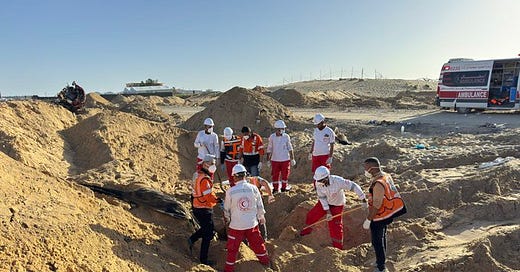



It seems I need to rid some Zionist trash from comments. One sec...
Thank you for this very important article.
You made a list of some of the known israeli strikes on ambulances so I must also add to the list the crew which went to rescue little Hind, and was deliberately murdered by the israeli tanks and guns.
https://mywisdom.substack.com/p/the-hammer-of-justice
Here my latest analysis,
https://mywisdom.substack.com/p/the-palestinian-holocaust-2023-2025
Once again thank you for your precious work and for sharing